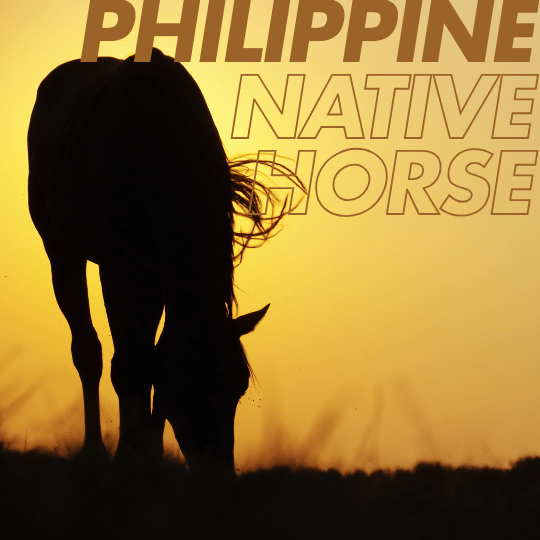
“I want my very own pet horse!” Make that the Philippine Native horse because we’re Filipinos.
That’s not something most Filipino kids think about. That’s kinda something a kid in the U.S. would think about.
But I did have that dream back when I was 5 or 6.
And it was because someone visited my lolo’s house and he had this great looking horse which he tied to the balimbing tree. I admired that horse for a long time while he talked with my grandfather.
After their conversation, the guy went back to his horse and rode off.
It was one of the coolest early memories I have that I cherish to this day.
I no longer want one as a pet though after experiencing what it’s like to ride one and care for one.
But I still would want one for the farm. Hey maybe it can be my son’s future pet.
Here I am seriously thinking about getting a horse. Heh.
A Little Basic Info About the Native Philippine Horse
The Native Philippine horse is smaller than many Western horse breeds. Despite that, they’re extremely strong for their size and can typically carry adult riders who are within their weight-carrying capacity (usually up to about 160-170 pounds).
They’re actually excellent riding horses, especially for beginners and children, due to their gentle temperament and manageable size.
Other things they are good for are:
- Trail riding in rough terrain
- Teaching children to ride
- Tourist activities
- Basic farm work
Of those things mentioned, the only one I haven’t done is ride one for tourist activities.
The Native Philippine horse has a compact and sturdy build, has relatively short legs and is about 46-54 inches at the shoulder. They weigh around 600-700 pounds, have deep chests, and come in a variety of colors.
They also live for 20-25 years.
These horses are generally docile and gentle making them ideal for small children. They are very patient and have shown a high intelligence making them easy to train. Additionally, these horses are generally calm, hardy, and resilient.
Riding these horses is easy too. They have strong hooves which makes them ideal for trail riding in tough terrain. I once rode one on a steep incline and although it was a scary experience, the horse took me to where I needed to go easily.
They have a smooth gait and good endurance. Just don’t try riding them for long distances because they’re not exactly built for that.
With the Availability of Exotic Breeds, What’s the Advantage of Getting a Philippine Horse?
The number one reason, and probably the most obvious is that these horses are already acclimated to the Philippines. That means they’re well-adapted to the tropical climate and can work in humid conditions. They’re also resistant to local diseases.
They also require less feed than larger breeds. They thrive on native grass, rice straw, and local vegetation. If you feed them oats, you’ll find out that they’re efficient feed converters.
Their low maintenance costs, good temperament, and ready adaptation to local climate conditions make them perfect for Filipinos.
With the advantages laid out, you should also know about the disadvantages. The Philippine Native horse is not suitable for larger adults. Someone like me, weighing at an even 200 pounds is too large for these horses.
Their population is declining and there aren’t enough breeding programs to bring those numbers up.
Performance-wise, these horses aren’t the fastest nor the strongest. They’re strong enough for some basic farm work but try not to overload them especially if they have to work in rough terrain.
Tips for Riding a Philippine Native Horse
And now for the main reason why one would want to get a pet horse: to ride them. Here are some tips for riding.
For Beginners

Riding a horse, any horse, starts with establishing trust with the animal. Horses are very sensitive, empathic beings and how you feel usually translates over to them and how they deal with you. So be calm and kind. And your horse will do the same thing with you in their own way.
Here’s how you start your relationship with your horse.
- Start with basic walking. Just take the reins and walk beside the horse. Keep your bodies in close proximity. Talking with hem also helps.
- Use proper safety equipment. In my case, the safety equipment was a burlap sack to prevent my skin coming in direct contact with the horse’ body. This prevents rashes. But if you can afford a proper sadly, go for it.
- Take lessons from experienced handlers. If I could go back in time, and I had the money, I’d pay someone to give me lessons. The basic lessons I got were just to establish trust, be calm and don’t move too much when you’re atop the horse.
- Respect weight limits. Know how much your horse can carry. If you’re pushing past 175 pounds, don’t ride the horse.
- Build trust gradually. Don’t rush it. Some horses are very trusting and only require a short introduction before they let you ride on their back. Some, unfortunately, will take days, weeks, and even months before they completely trust you.
For Experienced Riders
- Adjust riding style to pony size. This is applicable to those who’ve already experienced riding larger horses.
- Be aware of heat and working limits. Despite their acclimation to the Philippines, these horses are still vulnerable to heat stroke if it’s really hot outside.
- Respect traditional handling methods
- Consider terrain capabilities. Just because they can handle almost all types of terrain, try not to push your horse past its limits.
Things to Consider Before Buying a Philippine Native Horse
Price
And now the main reason why not a lot of us Filipinos have pet horses: the price of keeping one. Here’s a breakdown of the costs of keeping a Philippine Native horse.
First off, a young or untrained Native Philippine horse costs around ₱30,000 – ₱50,000. A trained one costs anywhere around ₱50,000 – ₱100,000.
But if you compare that to other types of horses, that price is a bargain. Consider the basic price of a quarter horse which costs around ₱150,000 – ₱300,000. If you go for one with show quality, that price rises to ₱300,000 – ₱800,000.
A basic Arabian can cost around ₱200,000 – ₱400,000. Show quality? ₱400,000 – ₱1,000,000!
Thoroughbreds, non-racing: ₱200,000 – ₱500,000. Racing quality: ₱500,000 – ₱2,000,000+
That ₱100,000 for a Philippine Native horse doesn’t seem so expensive now, does it?
Monthly Maintenance Costs
And now for the monthly maintenance costs. What? You thought buying one was a one time thing? Oh no… there’s more to owning a horse than just forking out the initial purchase cost.
Basic Care
- Feed
- Hay: ₱3,000 – ₱6,000
- Grain/Feed: ₱2,000 – ₱4,000
- Supplements: ₱1,000 – ₱3,000
- Boarding (if needed)
- Basic pasture: ₱5,000 – ₱8,000
- Full board: ₱10,000 – ₱20,000
- Premium facilities: ₱20,000 – ₱40,000
In lieu of paying for boarding, you can go ahead and build your own horse shed but that would entail a whole set of different costs. It’s going to be a good investment if you intend to keep not just one or two horses. Expect to shell out anywhere between ₱200,000 – ₱400,000 to build one.
Regular Care Services
- Farrier (every 6-8 weeks)
- Trimming: ₱800 – ₱1,500
- Shoeing: ₱2,000 – ₱4,000
- Veterinary Care
- Regular checkup: ₱1,500 – ₱3,000
- Vaccinations (annual): ₱5,000 – ₱8,000
- Deworming (quarterly): ₱500 – ₱1,000
Equipment & Supplies
Initial setup costs:
- Basic tack: ₱15,000 – ₱30,000
- Grooming supplies: ₱3,000 – ₱5,000
- First aid kit: ₱2,000 – ₱4,000
Additional Considerations
One-time Costs
- Transport to your location: ₱5,000 – ₱20,000
- Initial veterinary exam: ₱3,000 – ₱5,000
- Registration/papers (if applicable): ₱2,000 – ₱5,000
Optional Costs
- Insurance: ₱15,000 – ₱30,000 annually
- Training sessions: ₱500 – ₱1,500 per session
- Show entry fees: ₱2,000 – ₱10,000 per event
Location Factors
- Metro Manila/urban areas: Expect 20-30% higher costs
- Provincial areas: Generally lower costs
- Remote areas: Lower purchase prices but higher transport costs
Total Cost Estimates
Initial Investment
- Basic recreational horse: ₱100,000 – ₱200,000
- Show horse: ₱500,000 – ₱2,000,000+
- Initial setup costs: ₱25,000 – ₱50,000
Monthly Maintenance
- Basic care: ₱8,000 – ₱15,000
- Full care with boarding: ₱15,000 – ₱30,000
- Premium care: ₱30,000 – ₱50,000+
Final Tips and Thoughts Before Buying a Philippine Native Horse
Buying a horse is in no way a small purchase. And behind it is a large investment that’s going to be with you for 20 to 25 years. So, if you’re fully decided on getting a horse, be prepared for that mentally, emotionally, and most importantly, financially.
Consider your available resources, location and facilities. Also make sure you have enough emergency budget for unexpected medical expenses.
Always get a veterinarian to check the horse you are buying before you buy it and if at all possible, request documentation of health history.
If you’re a beginner, try getting a well-trained horse for a better experience. These horses basically do the riding for you and are not easily spooked by things they see on the road like the occasional weird tree or a slithering snake.
If you can, lease a horse instead of buying one or create a corporation to share the costs of owning a horse.

